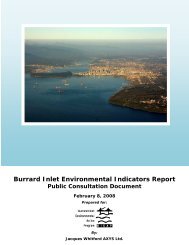Best Practices for the Reduction of Air Emissions From Construction ...
Best Practices for the Reduction of Air Emissions From Construction ...
Best Practices for the Reduction of Air Emissions From Construction ...
Create successful ePaper yourself
Turn your PDF publications into a flip-book with our unique Google optimized e-Paper software.
CHEMINFO<br />
• always mix thinner with <strong>the</strong> coating according to<br />
<strong>the</strong> manufacturer’s instructions; and<br />
• mixing operations should be undertaken to<br />
minimize <strong>the</strong> exposure <strong>of</strong> <strong>the</strong> coating to air (e.g.,<br />
in sealed containers).<br />
Some coatings manufacturers provide technical data<br />
sheets that include important in<strong>for</strong>mation about <strong>the</strong><br />
proper preparation and application conditions <strong>for</strong><br />
<strong>the</strong>ir products. This in<strong>for</strong>mation should be reviewed<br />
when preparing a coatings management plan and<br />
communicated to coatings applicators.<br />
7.4.1.3 Coatings Wastage Through Spillage and<br />
Splashing Should be Minimized<br />
Handling procedures should be designed to minimize<br />
coatings wastage through reduced spillage and<br />
splashing, <strong>for</strong> instance by adhering to <strong>the</strong> following:<br />
• During transfers, container lids, bungs, plugs, or<br />
valves may be opened or removed, but should be<br />
replaced or closed immediately after <strong>the</strong> transfer<br />
is complete;<br />
• If it is necessary to open coating containers <strong>for</strong><br />
prolonged periods, <strong>the</strong> use <strong>of</strong> flexible coverings<br />
(e.g., plastic film or sheet, fabric cloth) to cover<br />
<strong>the</strong> surface <strong>of</strong> <strong>the</strong> coating should be considered<br />
to minimize VOC losses;<br />
• During transfers <strong>of</strong> coatings from one container<br />
to ano<strong>the</strong>r, a pump and hose system should be<br />
used where possible to minimize fugitive VOC<br />
emissions. Vent holes in <strong>the</strong> source container<br />
should be opened to prevent <strong>the</strong> creation <strong>of</strong> a<br />
vacuum that might prevent adequate drainage<br />
and potentially lead to an unexpected large<br />
spillage;<br />
• If manual decanting from one container to<br />
ano<strong>the</strong>r must be done, it should be per<strong>for</strong>med<br />
slowly and carefully to minimize spillage and<br />
splashing; and<br />
• Where possible, separate pumping systems<br />
should be used <strong>for</strong> different paint colours to<br />
minimize flushing requirements. If this is not<br />
possible, colour applications should be<br />
sequenced to minimize flushing.<br />
7.4.1.4 Surface to be Coated Should be Properly<br />
Prepared<br />
Well-prepared surfaces will not need an excessive<br />
volume <strong>of</strong> coatings. Proper surface preparation can<br />
include: (i) removal <strong>of</strong> undesirable material from <strong>the</strong><br />
substrate; (ii) sealing <strong>of</strong> cracks and fissures; and (iii)<br />
sanding to achieve desirable roughness <strong>for</strong> proper<br />
coating adhesion. Surfaces to be coated should be<br />
prepared as per <strong>the</strong> coating manufacturers<br />
specifications. All dirt, rust, scale, splinters, loose<br />
particles, disintegrated paint, grease, oil, and o<strong>the</strong>r<br />
substances should be removed from all surfaces that<br />
are to be painted or o<strong>the</strong>rwise finished. Surface<br />
cracks or fissures should be filled with appropriate<br />
solid materials (putty, joint compounds), sealers or<br />
primers to minimize spaces where coatings can<br />
accumulate.<br />
7.4.1.5 Paint Heaters Should be Used Instead <strong>of</strong><br />
Paint Thinners<br />
Paint heaters should be used to heat coatings to<br />
reduce viscosity immediately be<strong>for</strong>e spraying. Paint<br />
heaters use an in-line heating element located just<br />
upstream <strong>of</strong> <strong>the</strong> spray gun. The use <strong>of</strong> paint heaters<br />
provides <strong>the</strong> necessary viscosity to <strong>the</strong> coating<br />
operation, without <strong>the</strong> use <strong>of</strong> solvent-based thinners.<br />
It should be noted that <strong>the</strong> use <strong>of</strong> paint heaters is not<br />
always applicable. For instance, <strong>the</strong> application <strong>of</strong><br />
heated paint to cold surfaces in winter months results<br />
in poor paint surface characteristics (i.e., cracking)<br />
because <strong>of</strong> <strong>the</strong> rapid cooling <strong>of</strong> <strong>the</strong> hot paint after it is<br />
applied to <strong>the</strong> cold surface.<br />
7.4.1.6 Technologically Advanced Spray-Guns<br />
Should be Utilized to Apply Coatings<br />
The most technologically advanced spray-guns<br />
should be utilized in order to apply coatings. VOC<br />
emissions can be significantly reduced by utilizing<br />
<strong>the</strong> most efficient spray guns with <strong>the</strong> highest<br />
transfer efficiency. Transfer efficiency is defined as<br />
<strong>the</strong> ratio <strong>of</strong> paint that adheres to <strong>the</strong> surface <strong>of</strong> <strong>the</strong><br />
product to <strong>the</strong> total amount <strong>of</strong> paint that leaves <strong>the</strong><br />
gun’s nozzle.<br />
Conventional high-pressure spray guns operate<br />
between 30 and 90 psi. The transfer efficiency <strong>of</strong><br />
<strong>the</strong>se high-pressure spray guns is poor. The high<br />
pressures associated with <strong>the</strong>se spray guns <strong>for</strong>ce paint<br />
<strong>Best</strong> <strong>Practices</strong> <strong>for</strong> <strong>the</strong> <strong>Reduction</strong> <strong>of</strong> <strong>Air</strong> <strong>Emissions</strong> <strong>From</strong> <strong>Construction</strong> and Demolition Activities 34
















